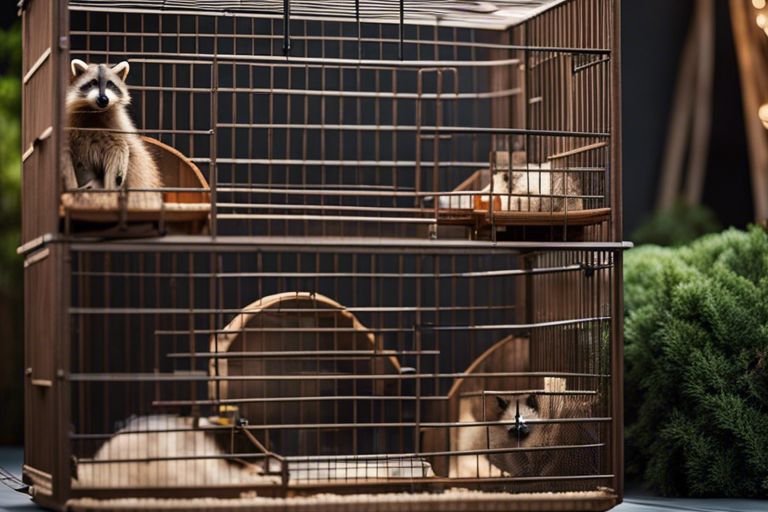How to Build a Raccoon Cage – Creating a Safe Habitat for Urban Wildlife
- Home
- How to Build a Raccoon Cage – Creating a Safe Habitat for Urban Wildlife

How to Build a Raccoon Cage – Creating a Safe Habitat for Urban Wildlife
Calamitous encounters with raccoons are not uncommon in urban areas. These nimble creatures are often driven to foraging in human habitats due to shrinking natural habitats. Creating a safe and secure raccoon cage can prevent dangerous interactions between humans and raccoons, while also providing a suitable habitat for these urban wildlife. In this blog post, I will guide you through the process of building a raccoon cage that will keep both the raccoons and your property safe. I will also provide essential tips and considerations for making your raccoon cage effective and humane, ensuring that you can coexist peacefully with these urban wildlife. Whether you are a homeowner or a wildlife enthusiast, this post will equip you with the knowledge and skills to construct a raccoon cage that meets the needs of these intelligent and resourceful animals.
Key Takeaways:
- Understanding the importance of creating a safe habitat for urban wildlife, such as raccoons, is essential for promoting coexistence and biodiversity in urban areas.
- Choosing the right materials for building a raccoon cage, such as sturdy wire mesh and solid wood, is crucial for ensuring the structure’s durability and effectiveness.
- Properly positioning the cage in a quiet, secluded area with easy access to food and water sources is essential for attracting raccoons and providing a safe environment for them.
- Maintaining the raccoon cage by regularly cleaning and providing fresh food and water helps ensure that the wildlife habitat remains safe and healthy for the animals.
- Seeking proper permits and regulations from local authorities before constructing a raccoon cage is important to avoid any legal issues and ensure compliance with wildlife protection laws.
Understanding the Needs of Urban Wildlife
Before building a raccoon cage, it is important to understand the needs of urban wildlife. As human development continues to encroach on natural habitats, urban wildlife such as raccoons are forced to adapt to living in close proximity to humans. Understanding their basic needs and behaviors is essential in creating a safe and humane environment for them.
The Behavior and Habitat of Raccoons
Raccoons are highly adaptable animals that are known for their intelligence and problem-solving abilities. They are nocturnal and are most active during the night, foraging for food and exploring their environment. Raccoons are opportunistic omnivores, meaning they will eat just about anything they can find, including fruits, nuts, insects, small mammals, and even human trash.
The Importance of Providing Safe and Humane Environments
Urban wildlife, including raccoons, often face numerous challenges when living in close proximity to humans. For raccoons, these challenges include the loss of natural habitat, increased exposure to vehicles and other urban dangers, and conflicts with humans. By providing safe and humane environments for raccoons, we can help mitigate some of these challenges and ensure their survival in urban settings.
Designing and Building a Raccoon Cage
As urban areas expand, human and animal interactions are increasingly common. Raccoons are resourceful and adaptable animals that have no trouble making themselves at home in urban environments. As a wildlife enthusiast, I find it important to create safe habitats for urban wildlife. Building a raccoon cage is a great way to provide a safe space for these animals while preventing them from accessing areas where they may cause damage. In this chapter, I will provide a step-by-step guide on how to design and build a raccoon cage that is both safe and effective.
Choosing Materials and Location
Some key factors to consider when choosing materials and location for your raccoon cage include durability, safety, and accessibility. When it comes to materials, I recommend using sturdy wire mesh or hardware cloth to build the cage. This will provide the necessary ventilation and security for the raccoons while keeping them safe from predators. Additionally, consider the placement of the cage. Choose a location that is easily accessible for maintenance and monitoring, but also away from high-traffic areas to minimize stress on the raccoons.
Construction and Assembly
When it comes to constructing and assembling the raccoon cage, attention to detail is crucial. Start by constructing the base and frame of the cage, ensuring that all pieces are securely fastened. Then, carefully attach the wire mesh or hardware cloth to the frame, making sure there are no gaps or loose ends that could pose a hazard to the raccoons. Lastly, install a secure and weatherproof door or entry point that can be easily opened for maintenance and cleaning.
Adding Enrichment and Shelter
Once the basic structure of the raccoon cage is complete, it’s important to consider adding enrichment and shelter for the raccoons. Incorporating features such as tree branches, rocks, and hiding spots can provide mental stimulation and a sense of security for the animals. Additionally, consider adding a sheltered area within the cage where the raccoons can seek refuge from the elements. Providing these amenities will help create a more natural and comfortable environment for the raccoons.
Maintaining and Monitoring the Raccoon Cage
For me, ensuring the ongoing maintenance and monitoring of the raccoon cage is essential to providing a safe and secure habitat for urban wildlife. Regular cleaning, sanitization, and inspection are crucial to prevent the spread of disease and ensure the well-being of the raccoons.
Cleaning and Sanitizing
When it comes to cleaning and sanitizing the raccoon cage, I recommend wearing protective gloves and using a mild detergent or bleach solution to scrub the entire enclosure thoroughly. Make sure to pay special attention to areas where food and waste are present, as these can be breeding grounds for bacteria and parasites. Rinse the cage well and allow it to dry completely before returning the raccoons to their habitat. Regularly changing and washing the bedding material is also important to maintain a clean and hygienic environment for the raccoons.
Regular Inspection and Maintenance
Regular inspections of the raccoon cage are necessary to identify any signs of damage, wear and tear, or potential safety hazards. I recommend checking for loose or damaged wires, broken or weakened barriers, and any signs of water damage or deterioration. It’s essential to repair any issues promptly to prevent escapes or injuries to the raccoons. Additionally, maintaining secure locks and latches on the cage doors is crucial to prevent unauthorized access and ensure the safety of the raccoons.
Conclusion
Taking this into account, creating a safe and humane habitat for urban wildlife such as raccoons is essential for coexisting with these creatures. Building a raccoon cage provides a practical solution for deterring raccoons from entering your home and protects them from potential harm. By following the steps outlined in this guide, you can ensure that your raccoon cage is both effective and safe for the animals. Remember to check local regulations and consult with wildlife professionals if necessary to guarantee that your efforts are in compliance with legal and ethical standards. With these considerations in mind, you can build a raccoon cage that contributes to a healthier and more harmonious relationship between humans and urban wildlife.
FAQ
Q: Why should I build a raccoon cage?
A: Building a raccoon cage provides a safe and humane habitat for urban wildlife, protecting both the raccoons and your property. By providing a designated space for raccoons, you can prevent them from causing damage or creating a nuisance in your surroundings.
Q: What materials do I need to build a raccoon cage?
A: To build a raccoon cage, you will need wire mesh, wood or PVC pipe for framing, hinges for the door, a latch, and various hand and power tools. It’s important to use durable materials that can withstand outdoor elements and the strength of raccoons.
Q: Where should I place the raccoon cage?
A: When choosing a location for the raccoon cage, it’s important to consider the safety of both the raccoons and your property. Place the cage in a quiet and secluded area, away from human and pet traffic. Ensure that the area provides natural shade and protection from harsh weather conditions.
Q: How do I secure the raccoon cage to prevent escapes?
A: To prevent raccoons from escaping, it’s crucial to secure the cage with strong latches and hinges that can withstand raccoon tampering. Additionally, ensure that the door of the cage is secure and cannot be easily manipulated from the inside by the raccoons.
Q: How can I make the raccoon cage environmentally friendly?
A: When building a raccoon cage, consider using non-toxic materials and avoiding harmful chemicals that could harm the raccoons or the environment. Additionally, incorporate natural elements such as plants and branches inside the cage to provide a more natural and enriching environment for the raccoons.
- Share
Mark Twain
Mark Twain stands at the helm of Create More Flow, infusing every sentence with the wisdom of his 15-year expeience through the seas of SEO and content creation. A former BBC Writer, Mark has a knack for weaving simplicity and clarity into a tapestry of engaging narratives. In the realm of content, he is both a guardian and a guide, helping words find their flow and stories find their homes in the hearts of readers. Mark's approach is grounded in the belief that the best content feels like a chat with an old friend: warm, inviting, and always memorable. Let Mark's expertise light up your website with content that's as friendly to Google as it is to your audience. Each word is chosen with care, each sentence crafted with skill - all to give your message the human touch that both readers and search engines love.
